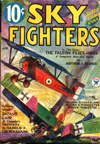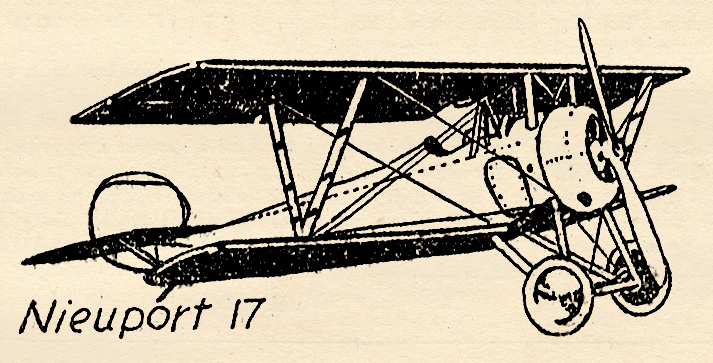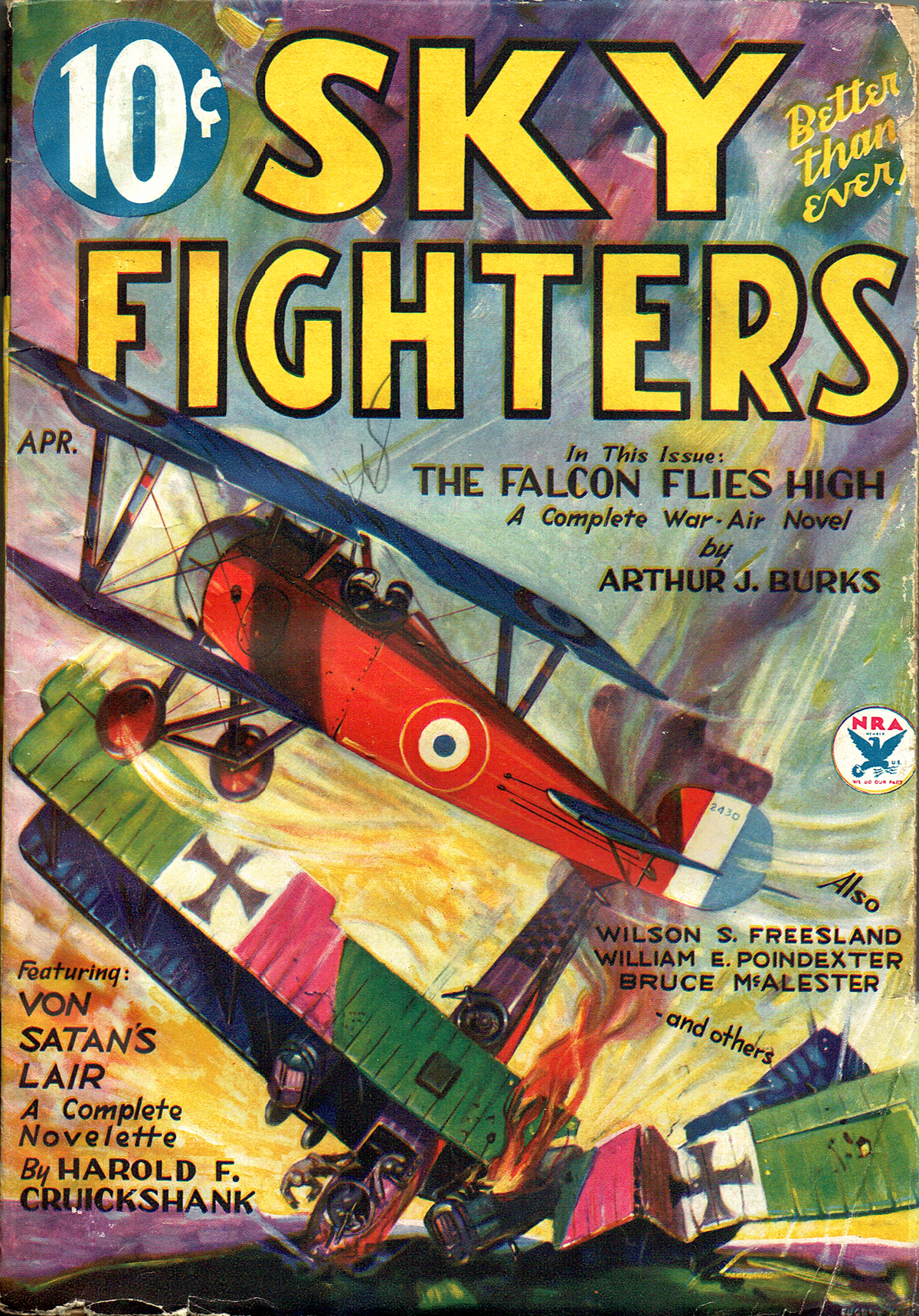“Sky Fighters, April 1934″ by Eugene M. Frandzen
Eugene M. Frandzen painted the covers of Sky Fighters from its first issue in 1932 until he moved on from the pulps in 1939. At this point in the run, the covers were about the planes featured on the cover more than the story depicted. On the April 1934 cover, Frandzen featured the Nieuport 17 and the giant Gotha bomber!
ON THE COVER this month  you will find two ships as radically different in design as you could wish for. The fleet little scrapper, the Nieuport 17 and the cumbersome engine of destruction, the Gotha bomber. The Nieuport was one of the most effective scouts that the French turned out. Owing to its high speed and maneuverability it was very popular with the French flyers. It was really a parasol in that the lower wing was so small that its chief function was to give girder strength to the upper wing. The Nieuports of this type were commonly called “one-and-a-half-planes.”
you will find two ships as radically different in design as you could wish for. The fleet little scrapper, the Nieuport 17 and the cumbersome engine of destruction, the Gotha bomber. The Nieuport was one of the most effective scouts that the French turned out. Owing to its high speed and maneuverability it was very popular with the French flyers. It was really a parasol in that the lower wing was so small that its chief function was to give girder strength to the upper wing. The Nieuports of this type were commonly called “one-and-a-half-planes.”
The big Gotha smacking the ground was just the last word in bombers as far as Germany was concerned. She built some bigger ones and stuck more engines on them than this 77 ft. twin-engined job, but in the case of the larger bombers they had plenty of trouble lifting them off the ground.

Slip back a few hours and take off with this broken Gotha as it leaves its home drome with a half a ton of bombs snuggled against its belly. With its two 160 horse power Mercedes churning the two pusher props more than four tons of ship and load are eased into the air. Two other giant bombers follow. The field is circled twice and then the three ships with their motors blasting orange streaks of flame from six exhaust stacks point their noses westward, toward the English Channel. The vibrating motors are laboring like mogul locomotives pulling a heavy train over a steep mountain grade—they are climbing. At last they reach twelve thousand feet, level off and throttle down to about sixty-five miles per hour. It is a clear night with high clouds scudding just below. Finally the nose of the leading Gotha is pointed downward. The other two follow. They slip down through the clouds. The Channel is below, now it has been passed. Again the bombers level off, wing slightly to the left. Scattered houses, the outskirts of London are below. Now the dwellings are bunched together. The gunner in the front pit has his eye glued to a Georz bomb-dropper’s sight. The pilot is watching his galvanometer, his left hand is on his bomb releases. Government buildings are now below at an angle of about twelve degrees.
Two giant bombs drop flatly from beneath the Gotha, lazily point their noses downward, then gathering momentum they go streaking down at their target. Buildings rock, flames spurt from shattered windows. Sirens from tops of buildings wail their eerie warnings through the chill before dawn air. AIR RAID. Again the bombs go racing toward the sleeping city. A ton and a half of high explosive has been released.

The British home defense planes are in the air, sweeping up to engage the giant destroyers, but already those dark shapes have slunk off into the blackness and are well out over the Channel.
The British were taken by surprise. They had not adequate speed in their protection planes. The advantage of the raiders was too great, they escaped across the Channel. But did they get back to their hangars behind the German lines? They did not! One was forced down with a balky engine. The two others ran into a dawn patrol of French airmen out looking for big game. Spandaus and Vickers snarled and spat lead as the eastern sky burst gloriously into color as the sun rose over the torn and twisted battle fields. A Vickers’ bullet found a vulnerable spot in the left engine of the Gotha pictured on the cover. Another killed the pilot. Flames, a dive, oblivion for the raiders. The Nieuport pilot circles the flamer once, salutes his fallen foe. It’s all in the day’s work.

Sky Fighters, April 1934 by Eugene M. Frandzen
(The Ships on The Cover Page)




